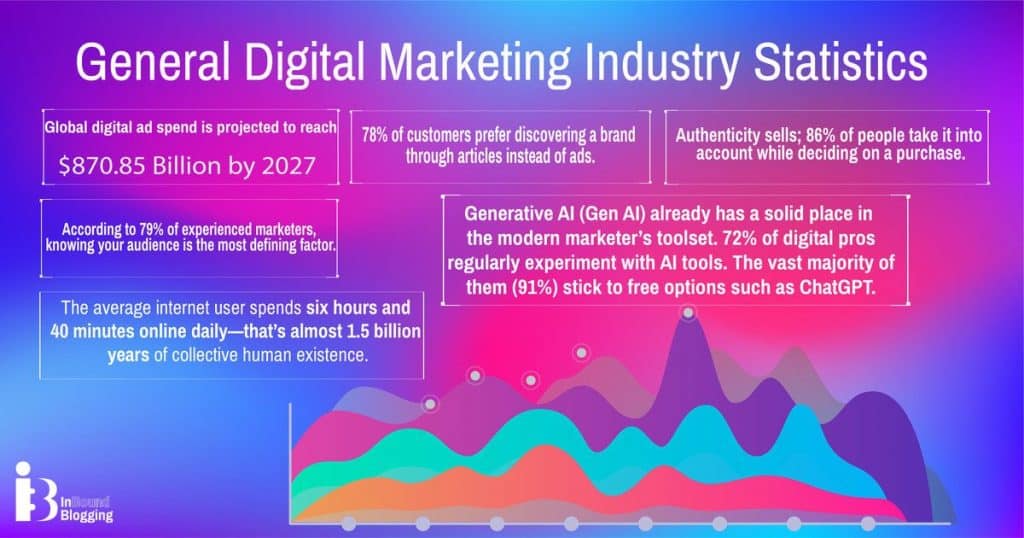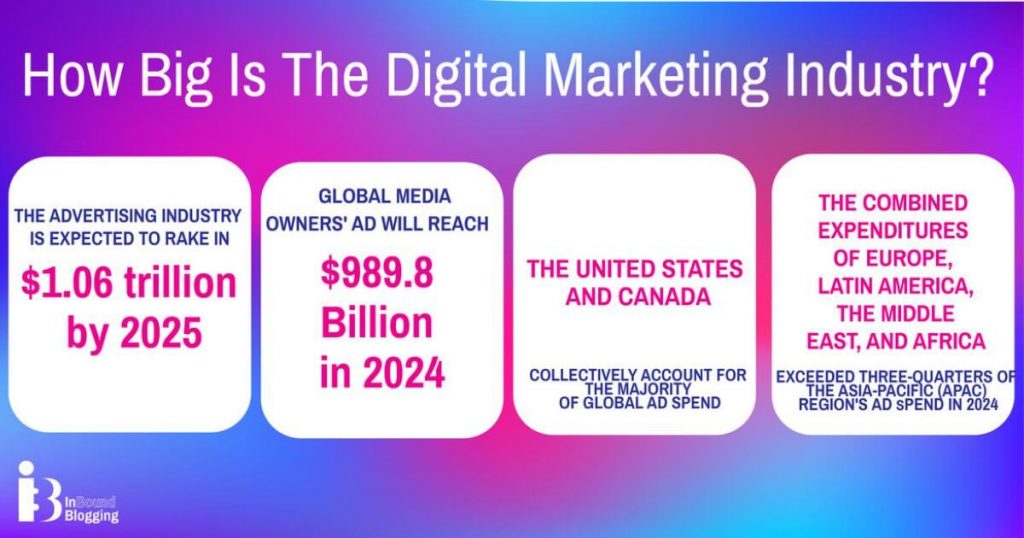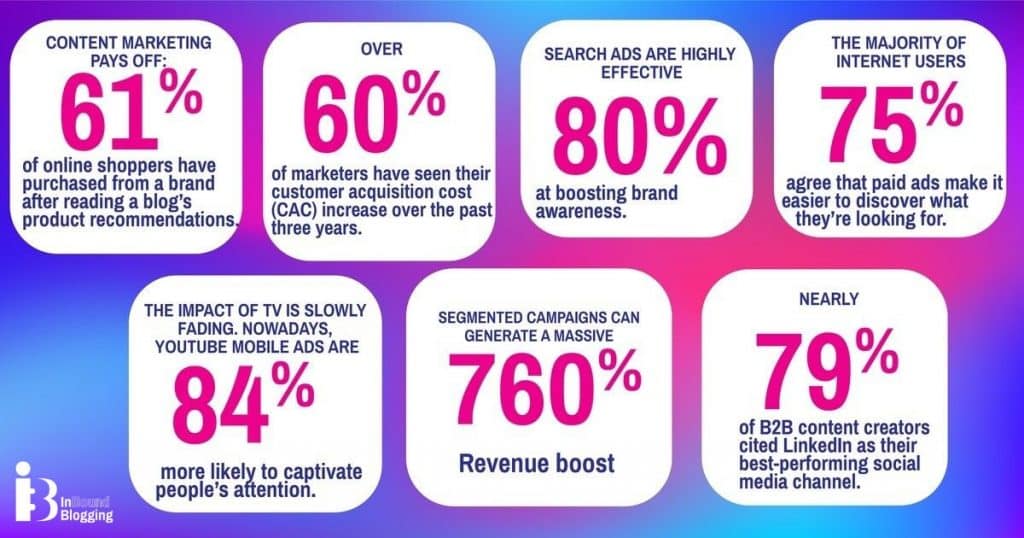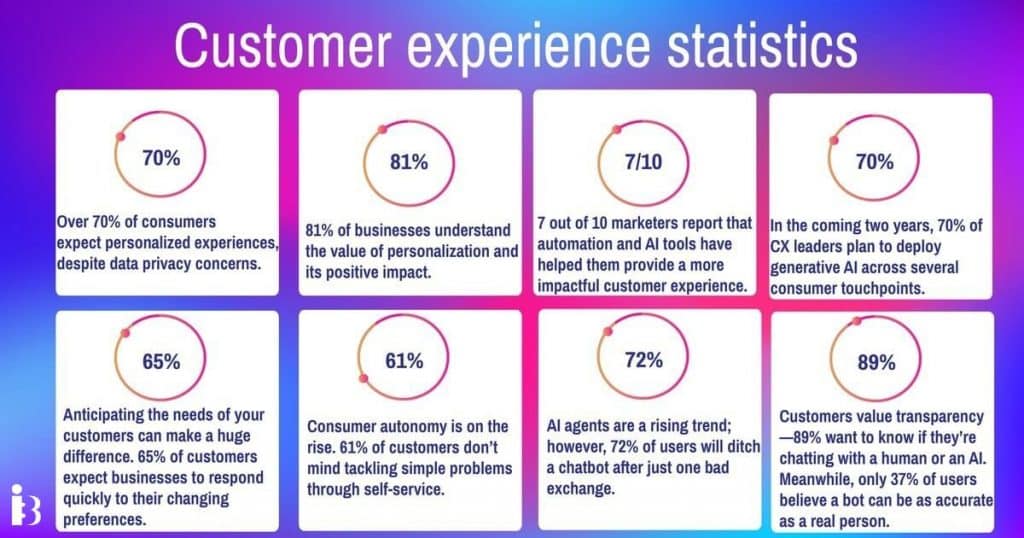Is digital marketing worth the hype in 2025?
Having a solid online presence comes with tons of perks. This is especially true for businesses that want to maximize their reach and profitability. The facts are clear—all the digital marketing statistics we’ll cover in this article prove that the internet is king in our connected world.
We’ve put together the freshest insights you need to sharpen your digital skills for 2025 and beyond. These stats are essential for anyone eager to keep up with the best marketing practices.
Let’s jump into it.
Essential Digital Marketing Stats [Key Findings]
- 68% of marketing and communications pros use artificial intelligence (AI) in their everyday workflows.
- Users are hungry for authenticity and personalized experiences—those are the hottest trends this year.
- Content undoubtedly is king—78% of customers say they would rather learn about a brand through articles than ads.
- Most marketers agree that video, in particular short-form content, is the best medium.
- Business-to-business (B2B) and business-to-consumer (B2C) marketers are on the same page that Facebook generates the best return on investment (ROI) out of all social media platforms.
- The top three key performance indicators (KPIs) for B2B marketers are conversions (73%), email engagement (71%), and website traffic (71%).
- Prioritizing mobile experiences is the way to go. More than 58% of people surfing the internet use their smartphones to get online.
General Digital Marketing Industry Statistics for 2025

No industry is left untouched in the internet age. Companies, big and small, are switching up their business models to cash in on online opportunities. After all, who wouldn’t want to be more accessible to their customers?
If you really ought to know why you’re choosing one strategy over another, here are some general digital marketing facts you should be aware of in 2025:
- Global digital ad spend is projected to reach $870.85 billion by 2027.
- 78% of customers prefer discovering a brand through articles instead of ads.
- Authenticity sells; 86% of people take it into account while deciding on a purchase.
- According to 79% of experienced marketers, knowing your audience is the most defining factor.
- The average internet user spends six hours and 40 minutes online daily—that’s almost 1.5 billion years of collective human existence.
- Generative AI (Gen AI) already has a solid place in the modern marketer’s toolset. 72% of digital pros regularly experiment with AI tools. The vast majority of them (91%) stick to free options such as ChatGPT.
We’re all well aware that AI is taking over the digital world. But why aren’t the remaining 28% of marketers incorporating AI into their daily routine?
Here’s what survey respondents had to say:
- The accuracy of the AI-generated results is the primary concern of marketers (36%).
- 27% cite a lack of understanding and internal training on how to use these technologies.
- Since large language models (LLMs) are trained on already existing data, marketers (22%) are worried about potential copyright infringements.
- Not all businesses are open to using AI. 19% of marketers are prevented from using these tools due to company policy.
How big is the digital marketing industry?

Asking this is a bit like questioning how big the internet itself is. The world of online advertising is booming. The market hit a massive $322.2 billion figure in 2022, and it’s been climbing ever since. Researchers on digital marketing industry growth statistics anticipate this figure to double by 2028, reaching $689.8 billion.
Are you still doubting the power of online channels? Maybe the figures below will convince you:
- Advertising is a profitable business—it’s expected that the industry will rake in close to $1.06 trillion by 2025.
- In 2024, global media owners’ ad revenue will reach an estimated $989.8 billion. This is a 7.8% increase from $918.2 billion in 2023.
- The United States and Canada collectively account for the majority of global ad spend.
- The combined expenditures of Europe, Latin America, the Middle East, and Africa barely exceeded three-quarters of the Asia-Pacific (APAC) region’s ad spend in 2024.
What is the growth rate of digital marketing?
Marketing has always been a fiercely fast-paced industry. However, the rise of Gen AI and our shrinking attention spans have made it even more cutthroat.
New challenges mean we have to come up with agile strategies that require higher budgets and investment in advanced technologies.
Take a look at what the latest digital marketing growth statistics say about this trend:
- By 2027, digital marketing is expected to account for nearly three-quarters of total global ad spend.
- Digital ad investments worldwide are on track to hit $871 billion by 2027. The US alone will surge by 50% from 2024 to 2028. Expenses are anticipated to climb from $303 billion to $452 billion.
- Meta reports that marketers can now reach nearly 2.2 billion users with Facebook ads each month.
- Inflation-adjusted growth in the top 12 markets (US, UK, Australia, Canada, Brazil, China, France, Italy, Germany, Spain, India, and Japan) is estimated at 2.6% in 2024. Media inflation remains high, however, particularly in TV and digital video services.
What is the success rate of digital marketing?

There are countless ways to spread the word about your business online. The rivalry is tough, but the payout is huge. So what results can you expect from your efforts? These digital marketing industry stats can give you some insights:
- Content marketing pays off: 61% of online shoppers have purchased from a brand after reading a blog’s product recommendations.
- Over 60% of marketers have seen their customer acquisition cost (CAC) increase over the past three years.
- Search ads are highly effective (80%) at boosting brand awareness.
- The majority of internet users (75%) agree that paid ads make it easier to discover what they’re looking for.
- The impact of TV is slowly fading. Nowadays, YouTube mobile ads are 84% more likely to captivate people’s attention.
- Creative, interactive, and personalized—these three words define successful emails. Segmented campaigns can generate a massive (760%) revenue boost. Adding video is another effective trick that increases click-through rates by 300%.
- In a recent global survey, nearly 79% of B2B content creators cited LinkedIn as their best-performing social media channel.
What percent of marketing is digital?
Digital marketing is on fire, pulling budgets away from traditional marketing methods faster than ever. Client engagement is much higher and way easier to monitor online. Most people turn to smartphones for everything—from shopping to casual doomscrolling.
Here’s what the numbers have to say:
- With a predicted 7.4% increase in 2024, digital advertising continues to flourish. Nearly 60% of the global ad spend goes to online formats. The biggest contributors to this are retail media, paid social ads, and paid search.
- In the upcoming four years, 70% of digital ad spending will come from mobile platforms.
- Programmatic ads are the future—smarter, faster, and more targeted than anything we’ve seen before. By 2028, they will account for 81% of all digital ad revenue.
- In-app advertising will reach an estimated $63.7 per user in 2024.
Digital Marketing Statistics by Channel and Type
What do the best marketing professionals do differently from the rest? They already know all the statistics on digital marketing listed below. Keep reading to compare your own strategy with what’s actually working right now.
Search marketing statistics
Nine out of ten people form an opinion about a business only after researching it online. Thanks to search engine optimization (SEO) and pay-per-click (PPC) advertising, brands have more reach than ever.
Securing a leading position in the search engine results pages (SERPs) is a massive visibility boost. Marketers report that SEO has resulted in more ROI (16%) than any other digital channel. The power of search is undeniable, and the stats don’t lie:
- Search engine marketing (SEM) continues to grow. Experts anticipate that global ad spending will reach $306.7 billion in 2024. This tendency is expected to persist, with a projected annual growth of 8.01%.
- According to internal reports from Google, for every $1 spent on Google Ads, businesses earn an estimated $2 in revenue. Organic results perform better since companies receive about five times more clicks on their search results compared to their ads.
- Google’s dominance is undeniable—the tech giant occupies around 95% of the search engine market share.
- The organic top position on Google search results generates a 39.8% click-through rate (CTR). The second spot receives 18.7% of traffic, which is a notable dropoff in clicks. Landing a featured snippet increases the CTR to a staggering 42.9%.
- 92% of consumers search for product reviews on their mobile phones before committing to a purchase. Reviews by other customers play a huge role in their decision-making process.
- 63% of Millennials turn to search engines to read online reviews about products and brands they’ve never tried before.
- About 45% of users head to a site’s search page after landing on a business’s homepage. Another 28% navigate to a specific product detail page, especially if a well-targeted ad influenced them in advance.
Customer experience statistics

What defines an exceptional customer experience (CX)? The keyword is personalization. It works wonders for brands, and nearly everyone agrees—96% of businesses say it almost guarantees return buyers, and 94% believe it boosts sales.
Look at the following digital marketing industry stats that solidify this trend:
- Over 70% of consumers expect personalized experiences, despite data privacy concerns.
- 81% of businesses understand the value of personalization and its positive impact.
- 7 out of 10 marketers report that automation and AI tools have helped them provide a more impactful customer experience.
- In the coming two years, 70% of CX leaders plan to deploy generative AI across several consumer touchpoints.
- Anticipating the needs of your customers can make a huge difference. 65% of customers expect businesses to respond quickly to their changing preferences.
- Consumer autonomy is on the rise. 61% of customers don’t mind tackling simple problems through self-service.
- AI agents are a rising trend; however, 72% of users will ditch a chatbot after just one bad exchange.
- Customers value transparency—89% want to know if they’re chatting with a human or an AI. Meanwhile, only 37% of users believe a bot can be as accurate as a real person.
Content marketing statistics
Today’s consumers are bombarded with tons of ads daily. So much so that over 35% of global internet users use an ad blocker while browsing online. It’s estimated that this will cause a massive $54 billion loss in ad revenue in 2024.
It’s obvious—users crave content that informs and adds value. That’s why content marketing is a top-performing strategy for businesses of all sizes.
Short-form videos are the hottest trend in content right now. But blogging, podcasts, and live streaming are worth the investment too. Check out what the numbers say:
- Video continues to deliver the highest ROI among all content formats. Short-form videos in particular generate the best ROI (17%).
- In 2024, 30% of marketers intend to start focusing on platforms such as TikTok, YouTube shorts, and Instagram reels.
- Business websites with blogs pull 67% more leads monthly compared to those without.
- Interacting with authentic content generates 103.9% more conversions, so consider incorporating user-generated content (UGC) like images or videos in your strategy.
- Blogging stats show that the average business blog post takes just under four hours to write and is 1,427 words long.
- The most important measurement of content performance is traffic—55% of marketers prioritize this metric. This is closely followed by social media engagement and shares with 50%.
- 48% of social media marketers say yes to content syndication. Nearly half of all experts repurpose content in various formats, while 34% create new content for each platform they use.
Businesses that don’t use AI mostly stick to a modest budget. Stats about digital marketing show that most companies spend less than $1,000 a month on content creation. Very few can afford to allocate more.
Take a peek at this detailed breakdown:
| Content marketing budget range | Percentage |
| Less than $1,000 | 71% |
| $1,000–$2,000 | 12% |
| $2,001–$4,000 | 8% |
| $4,001–$6,000 | 4% |
| $6,001–$10,000 | 3% |
| $10,001–$20,000 | 1% |
| Over $20,000 | 1% |
Data-driven marketing statistics
These days, our personal information is easily accessible. It shouldn’t be surprising that 75% of people believe data privacy is a fundamental human right.
The truth is that in today’s interconnected world, information is our most valuable asset. We no longer exist in a market where just having data suffices—those aiming to thrive must act on insights. Hubspot’s 2024 State of Marketing Report calls this shift the “Intelligence Era.”
Here’s how marketers should adapt:
- With Google phasing out third-party cookies, self-reported user data from preferences and content insights are the most reliable alternatives for data collection.
- Only 65% of marketers currently report having high-quality data on their target audience.
- Email is the most reliable channel for collecting first-party data. However, just 24% of email programs are properly integrated with other channels—a missed opportunity for cross-channel communication.
- Data-driven marketing strategies are particularly useful for enhancing customer experiences. However, only 33% of people believe brands handle user data responsibly.
Here are the top three common bottlenecks marketers bump into when dealing with data:
- Around 45% of digital experts say that segmenting audiences is their biggest challenge.
- Data-driven real-time decision-making is a hurdle for 38% of marketers.
- About 32% struggle with finding and maintaining high-quality data.
Brand awareness statistics
Something exciting is happening online! People aren’t just scrolling past branded content anymore—they’re actively seeking it out.
Building brand recognition is fundamental to long-term success in the digital age. How people research and interact with brands online affects which tactics work. Marketing managers need to pay attention to the following facts:
- Research on consumer preferences shows that 68% of users follow a brand to stay informed about their products and services.
- Leaders must nurture their reputation carefully—48% of consumers don’t trust that companies with unpopular CEOs will safely handle their data.
- It takes five to seven impressions for a person to remember your business. Consistent branding across all channels helps speed this up.
- If you want to leave a lasting impression on your followers, you must communicate with them. 51% of users say the most memorable brands are the ones that respond to them. This is especially true for younger consumers who prioritize one-on-one connections.
- Resolving customer complaints quickly isn’t enough anymore; 76% of consumers think customer support and fast response times are equally important.
- Your loyal fans can be your best brand advocates—66% of online consumers are tempted to buy from a new business after seeing social media posts from happy customers.
But there is some troubling news for businesses: many consumers feel like there is too much branded content online, especially on social platforms. Here’s what the numbers show:
- Curb the sales pitch. 59% of people think too much advertising is cluttering their social media. One-third of all users would rather see no branded content at all.
- Be careful about the frequency and quality of your content—more than half of all users will unfollow business pages that share “annoying” posts.
Email marketing statistics
Does your business have a newsletter? If not, you’re missing out on one of the best-performing marketing channels.
Despite the undisputed dominance of social platforms, email remains a high-converting online marketing tool. Many businesses are still adjusting to the loss of third-party cookies, but email is well-positioned to bridge the gap.
- One of every three marketers says they use email, and 87% intend to keep or boost their spending in 2024.
- Your email subject line can define the success of your entire campaign—47% of people click on an email based on that alone.
- 69% of users send emails with an unappealing subject line straight to the spam bin.
- 30% of businesses have chosen to invest more in their total email marketing spend.
- Email has an impressive average ROI of $36 for every $1 spent. However, 72% of marketers don’t keep track of their email ROI.
- The most important KPIs that email marketers care about are sales and revenue growth.
- Personalization with AI-powered email marketing tools boosts ROI by up to 70%.
- 45% of teams currently use AI to help them create email content.
Social media marketing statistics
A well-managed social media account is the perfect place to inform your followers about any special offers or sales. Invite your followers to join real conversations and position your brand as a top knowledge source in your industry. The statistics about digital marketing on social platforms say it all: your customers expect to see you there. Here’s why:
- Social media is the most accessible touchpoint between businesses and customers.
- There are over five billion social media users in 2024. This number is expected to grow to over six billion by 2028.
- People spend about 151 minutes per day on social media and messaging apps.
- Facebook holds the crown as the most popular social platform, with 2.9 billion active users.
- Reports show that influencer marketing campaigns can generate an impressive 578% ROI. This makes them one of the most lucrative advertising strategies for businesses.
- Virtual influencers are on the rise, and over 60% of marketers have used them in their campaigns.
Looking further into the social platform preferences of different generations gives us even deeper insights. These digital marketing stats reveal who’s using what:
| Generation | Age range | Favored social media platforms |
| Gen Z | 18–29 years | Snapchat (41%), TikTok (35%), Instagram (32%) |
| Millennials | 30–39 years | LinkedIn (34%), X/Twitter (34%), Snapchat (33%), Instagram (32%) |
| Gen X | 40–49 years | LinkedIn (25%), Facebook (22%), X/Twitter (21%) |
| Boomers | 50–59 years | Facebook (29%), LinkedIn (24%), Pinterest (24%) |
eCommerce statistics
eCommerce has made shopping more convenient than ever. You can buy everything while lounging at home—clothes, furniture, groceries, you name it. Sales and marketing in 2025 put online shoppers at the forefront.
Here are some statistics you need to know about the newest ecommerce marketing trends:
- Over 26 million ecommerce websites are competing for consumer attention online.
- Global retail ecommerce sales are expected to grow by 39% over the coming years, with projections indicating they will surpass $8 trillion by 2027.
- China has the largest ecommerce market in the world. Online sales in the country make up nearly half of all retail transactions.
- Amazon is forecasted to surpass the Chinese retailer Alibaba as the largest global ecommerce business. Experts anticipate Amazon’s online sales will reach $1.2 trillion in 2027.
- User-generated content is a huge contributor to ecommerce success. 80% of shoppers say they’re more likely to buy from an online store if they see videos and photos from real clients.
- Real testimonials contribute to sales—58% of users have left an online shop without a purchase due to the lack of customer reviews.
- Consumer behavior analysis found that aiming for a rating above 4 stars on a reviews website is solid, while a 4.75 rating is the ideal target.
Digital Marketing vs Traditional Marketing Statistics
Businesses often have a tough time making smart marketing plans, which can really impact their bottom line. Settling on the right advertising medium is one of these strategic decisions.
Оffline marketing with print ads, billboards, TV, and radio is still widely used. That said, when we gathered these digital marketing vs traditional marketing stats, it’s easy to see why online channels have an edge.
Let’s learn more:
- Digital out-of-home ad revenue is set to hit around $20.4 billion in 2024. If you throw traditional outdoor ads into the mix, the overall ad growth is expected to be around 11.5%.
- Television hasn’t been the king of advertising ever since the internet took that spot. Over half of US adults still use some sort of TV service; however, this medium is losing ground. It took a steep drop of 20% from 2014 to 2023, and this tendency will most likely continue.
- A recent study found that 59% of people think YouTube ads are more relevant than those on regular TV and streaming websites.
- Traditional B2B advertising in the US is still going strong. Spending is expected to bump to more than $19 billion in 2024. However, many B2B marketers plan to scale back their traditional ad spending by about 3.64%.
It’s no wonder that digital media is where businesses invest the bulk of their marketing budget nowadays. Here’s a look at the global ad spending across various media types in 2024:
| Media type | Projected global ad spend share |
| Digital channels | 59% |
| Television | 23% |
| Print media | 6% |
| Out-of-home (OOH) ads | < 11% (combined with audio and cinema) |
Digital Marketing vs Inbound Marketing Statistics
Mass advertising often targets broad audiences. This can be a bit of a gamble. Inbound marketing takes care of that issue. Instead of reaching out to potential clients, you use techniques that let people find your business organically.
Is it effective? Let’s see what the numbers tell us:
- Inbound tactics can bring in 54% more leads compared to traditional outbound methods.
- Inbound marketing can double a website’s conversion rate, boosting it from 6% to 12%.
- B2B marketing stats show that using inbound methods saves companies about $14 for every new lead they bring in.
- Marketing teams that use customer relationship management (CRM) systems are 128% more likely to have an effective strategy in place.
Other Digital Marketing Stats and Facts
Now you know the basics of what’s hitting and what’s missing in the digital world. But there are more trends worth including in our overview. You don’t want to miss out on these—they might be key to your next best content strategy.
Let’s explore more exciting digital marketing statistics 2025 has to offer:
Gen Z marketing statistics
People have always been intrigued by generational differences. Now, the internet highlights them more than ever. It’s easy to tell by a user’s lingo and behavior online when they were born.
But what sets apart Gen Zers from older people and their boomer mentality? These fascinating generational trends and stats on digital marketing reveal it all:
- Unsurprisingly, TikTok and Snapchat dominate the social media habits of Generation Z, with these platforms being the clear favorites for younger audiences.
- Influencers are the top brand ambassadors for Gen Z—45% of them look up to online personalities for product recommendations. For comparison, only 18% of young shoppers look up to their friends for brand inspiration.
- Generation Z has a keen eye for what is real or fake on the internet. This includes marketing tactics too. 53% of young shoppers are skeptical of flawless 5-star product ratings.
- Social media is transforming into the search engine of the future, not just for Gen Z but in general. 43% of Millennials already use social media to discover new products. Gen Z and Gen X closely follow this tendency with 40% each.
- For younger people, in-app purchases on social platforms are becoming the norm.
- One in four Gen Zers, Millennials, and Gen Xers now prefer sliding in a brand’s direct messages (DMs) to reach customer service.
Photo and video marketing statistics
Most of the content we consume on a daily basis comes in visual form. Think about it—when was the last time you read a full blog post? Now think back to how many photos and videos you scroll past in just a few minutes online. As marketers, we can’t ignore the power of this medium.
Look closely at these stats if you’re not convinced:
- Video marketing is a big deal these days—over 90% of businesses are jumping on the bandwagon.
- About 48% of video marketers mostly whip up live-action content. Animated (24%) and screen-recorded (22%) videos are still used but not as frequently.
- AI has made its mark on this creative field as well. A solid 75% of marketing experts are using AI tools to make their videos.
- Short-form content rules the web. According to 39% of professionals, the sweet spot is 30–60 seconds in length.
- Most people (44%) would rather watch a video than read a guide on a product or service. Overall, videos are considerably more effective than images and text-based content.
- Don’t underestimate the power of UGC visuals. Almost half of shoppers are way more likely to click with a brand if they feature their photos or videos. Plus, a huge chunk of Gen Z (86%) and Millennials (81%) are more likely to shop from websites that show off photos taken by real users.
Marketing automation statistics
AI’s game-changing potential is not displacing anyone—people and algorithms are teaming up. The modern-day digital marketer often wears several hats at work. Mastering advanced automation tools is something every professional needs to know.
Let the stats persuade you if you’re feeling skeptical:
- Digital marketing stats show that the automation industry is set to hit $6.6 billion in 2024. This is expected to double by 2030, particularly thanks to the rise of AI technology.
- 36% of marketers already use AI chatbots in their roles. An additional 58% of experts plan on increasing their investments in AI and automation solutions in 2024.
- In 2024, 58% of marketing decision-makers are automating their email efforts. 49% have automation for social media, and 33% use it for content management.
- About 41% of digital experts describe their customer journeys as mostly or fully automated.
- Marketers are mostly satisfied with automation—70% claim it is somewhat beneficial, while 30% feel it is absolutely worth it. Only 3% say it didn’t work out.
Omnichannel marketing statistics
With all the different platforms out there, it’s challenging to sift through the clutter and find what truly draws traffic and leads. A one-size-fits-all strategy for predicting customers’ needs doesn’t cut it anymore.
Here are some digital marketing stats for 2025 that can help you tackle these issues:
- Modern-day consumers expect to shop on any platform and device and want the option to get their orders delivered anywhere. Retailers who can’t respond to these demands risk losing 10–30% of their sales. For marketers everywhere, this should ring a bell: diversify your channels.
- Research shows that an omnichannel approach drives six times more sales than using a single channel.
- Keep your online inventory updated—62% of shoppers check product availability online before visiting a local store.
Text marketing statistics
Marketing technology changes frequently, but there are evergreen tactics that consistently deliver good results. One of these timeless strategies is texting.
If we compare digital marketing ROI statistics, some channels will outpace others. Regardless, text-based advertising manages to hold steady. Surprisingly, it still works effectively in our visuals-driven era. Explore these stats for further proof:
- In 2024, 87% of marketers plan to continue or increase their investment in mobile messaging through channels like SMS, Facebook Messenger, and WhatsApp.
- Around one in five marketing specialists currently uses mobile messaging. 10% say it’s a top driver of ROI, and 12% plan to invest in mobile for the first time in 2024.
- Campaigns that include SMS can be 429% more likely to end in a conversion than single-channel marketing efforts.
- If you’re not asking your followers to turn their notifications on, it’s time to start. 38% of users who clicked on a push notification ended up making a purchase.
With the rise of mobile devices, digital marketers’ efforts literally end in the hands of users—take a look at these powerful mobile marketing stats for confirmation.
Final Thoughts
Feeling inspired after checking out the major digital marketing stats 2025 has in store for us? Marketing teams must get extra efficient and focus on creating smooth, tech-friendly experiences.
This field is always changing—new strategies and tools pop up nonstop. But if you make it a habit to read about the current trends, you’ll stay one step ahead of your competitors. So hop on these trendy industry changes, give AI a try, and keep creating authentic customer journeys.
Eager for more stats? Check out these PR statistics next.
References
- https://www.conference-board.org/research/CMO-CCO-Meter/AI-Marketing-Communications-survey
- https://www.zippia.com/advice/branding-statistics/
- https://www.statista.com/statistics/1284484/social-media-platforms-highest-return-on-investment/
- https://www.statista.com/statistics/1373077/metrics-b2b-content-marketing/
- https://www.statista.com/statistics/277125/share-of-website-traffic-coming-from-mobile-devices/
- https://www.statista.com/statistics/237974/online-advertising-spending-worldwide/
- https://contentmarketinginstitute.com/articles/b2b-content-marketing-trends-research/
- https://www.globenewswire.com/en/news-release/2023/09/21/2747046/28124/en/689-8-Billion-Digital-Marketing-Market-Analysis-by-Digital-Channel-End-Use-Industry-and-Region-Global-Forecast-to-2028.html
- https://www.statista.com/statistics/236943/global-advertising-spending/
- https://www.statista.com/statistics/242552/digital-advertising-spending-in-the-us/
- https://datareportal.com/reports/digital-2024-global-overview-report
- https://www.webfx.com/wp-content/uploads/2024/07/101-digital-marketing-statistics-2024.pdf
- https://www.statista.com/statistics/311524/effectiveness-of-b2b-social-media-content-marketing/
- https://info.dentsu.com/AdSpendMay2024
- https://www.statista.com/outlook/dmo/digital-advertising/worldwide
- https://resumelab.com/cover-letter-examples/digital-marketing
- https://www.statista.com/outlook/dmo/digital-advertising/search-advertising/worldwide?currency=usd
- https://economicimpact.google/methodology/
- https://gs.statcounter.com/search-engine-market-share/mobile/worldwide
- https://firstpagesage.com/reports/google-click-through-rates-ctrs-by-ranking-position/
- https://www.powerreviews.com/the-complete-guide-to-ratings-reviews-2024-edition/
- https://www.criteo.com/onsite-shopper-behavior-report/
- https://www.zendesk.com/blog/cx-trends-2024/
- https://www.salesforce.com/content/dam/web/en_us/www/documents/e-books/service/sixth-edition-state-of-service.pdf
- https://www.statista.com/statistics/351862/adblocking-usage/
- https://www.statista.com/statistics/454511/ad-blocking-cost-worldwide/
- https://www.orbitmedia.com/blog/blogging-statistics/
- https://www.hubspot.com/marketing-statistics
- https://www.semrush.com/goodcontent/api/ai-content-marketing-report/download/Think_Big_with_AI_Small_Business_Content_Marketing_in_2024.pdf
- https://blog.hubspot.com/marketing/state-of-consumer-trends-report
- https://cdn.shopify.com/static/plus/resources/Commerce_Trends_Report_2023_Shopify.pdf
- https://www.statista.com/statistics/1450009/challenges-data-driven-marketing-strategy/
- https://sproutsocial.com/insights/index/
- https://www.nosto.com/wp-content/uploads/2021/08/Stackla-Post-Pandemic-Shifts-in-Consumer-Shopping-Habits-Data-Report_FINAL_compressed.pdf
- https://www.hootsuite.com/research/consumer-report
- https://funnel.io/blog/signal-based-marketing
- https://optinmonster.com/101-email-subject-lines-your-subscribers-cant-resist/
- https://www.litmus.com/resources/state-of-email-innovations
- https://www.statista.com/statistics/278414/number-of-worldwide-social-network-users/
- https://www.threekit.com/blog/how-to-build-interest-salesforce-product-configurator-twitter
- https://influencermarketinghub.com/influencer-marketing-benchmark-report/
- https://sproutsocial.com/insights/new-social-media-demographics/#social
- https://www.statista.com/statistics/1337525/us-distribution-leading-social-media-platforms-by-age-group/
- https://www.statista.com/statistics/379046/worldwide-retail-e-commerce-sales/
- https://www.statista.com/statistics/272951/global-digital-out-of-home-advertising-expenditure-since-2000/
- https://www.statista.com/statistics/467842/pay-tv-penetration-rate-usa/
- https://blog.google/products/ads-commerce/the-youtube-effect-new-ways-to-reach-engaged-audiences/
- https://www.statista.com/statistics/1133213/us-b2b-change-digital-vs-traditional-marketing/
- https://www.statista.com/statistics/245440/distributuion-of-global-advertising-expenditure-by-media/
- https://www.sender.net/blog/inbound-marketing-statistics/
- https://www.thedrum.com/opinion/2023/03/03/creators-we-trust-gen-z-s-loyalty-influencers
- https://www.wyzowl.com/video-marketing-statistics/
- https://www.statista.com/statistics/1269813/marketing-channels-automation/
- https://www.statista.com/statistics/1372872/automation-marketing-customer-journey/
- https://www.imd.org/research-knowledge/agility/articles/why-omnichannel-will-define-retail-in-2021-the-surprising-comeback-of-the-physical-store/
- https://www.omnisend.com/blog/omnichannel-statistics/
- https://www.digitalcommerce360.com/product/omnichannel-report/
- https://www.hubspot.com/hubfs/2024%20State%20of%20Marketing%20Report/2024-State-of-Marketing-HubSpot-CXDstudio-FINAL.pdf?hubs_signup-url=www.hubspot.com%2Fstate-of-marketing&hubs_signup-cta=Submit


![The Best Email Marketing Tools to Boost Your Campaigns in 2024 [Based on Survey Results] Best Email Marketing Tools](https://inboundblogging.com/wp-content/uploads/2024/08/best-email-marketing-tools-150x150.jpg)
